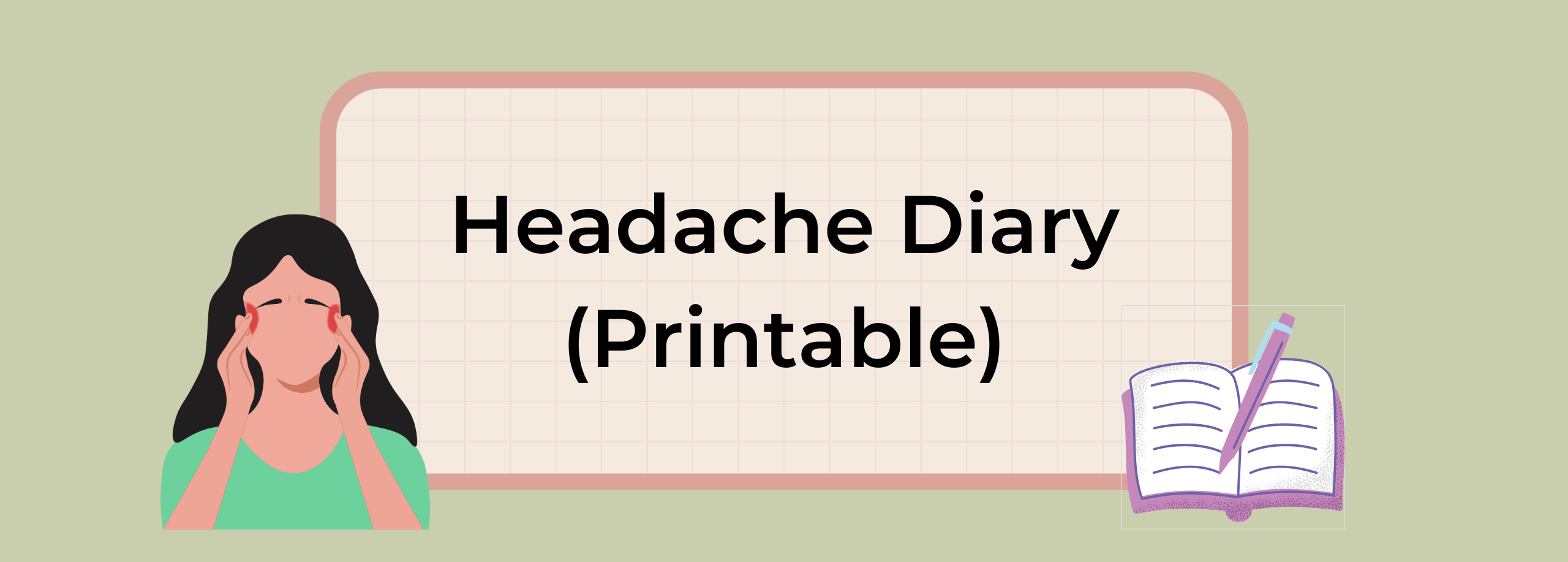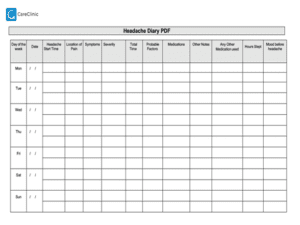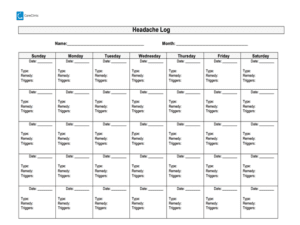 If you are someone who suffers from headaches on a regular basis, it is important that you keep track of them. This can be done by using a headache diary. Doctors often recommend keeping a headache diary, as it can help to identify patterns and improve treatment outcomes.
If you are someone who suffers from headaches on a regular basis, it is important that you keep track of them. This can be done by using a headache diary. Doctors often recommend keeping a headache diary, as it can help to identify patterns and improve treatment outcomes.
There are many different types of headaches, such as migraines and tension headaches. Each type of headache can have its own set of symptoms. By keeping track of your headaches, you may be able to find a pattern and figure out what is causing them. You can print out a headache diary in pdf format, or create one in Microsoft Excel. Alternatively, there are many headache diary apps available that make tracking your headaches easy!
There are many types of headaches, such as:
- Migraine headaches (Migraine attacks are often characterized by throbbing pain, sensitivity to light, and nausea. Some people also experience an aura, which is a warning sign that a migraine is about to begin.)
- Tension headaches (Tension headaches are the most common type of headache. They feel like a tight band around your head)
- Cluster headaches (Cluster headaches are a type of headache that come in groups or clusters. They are usually very severe and can last for weeks or even months)
- Hormone headaches (Hormonal changes can trigger headaches. These types of headaches are more common in women)
- Sinus headaches (Sinus headaches are caused by inflammation of the sinuses. They are often accompanied by a fever and runny nose)
- Rebound headaches (Rebound headaches are caused by overuse of pain medication. They can be difficult to treat and may require a change in medication)
What are the main symptoms?
The most common symptoms of a headache are:
- Pain (usually on both sides of the head)
- Tenderness on the scalp, neck, and shoulders
- Difficulty concentrating
- Fatigue
- Mood changes
Each type of headache has its own set of symptoms. By keeping track of your headaches, you may be able to find a pattern and figure out what is causing them. There are many different ways to relieve the symptoms of headaches. Some common relief measures include:
- Taking over-the-counter medication such as ibuprofen or acetaminophen
- Applying ice or heat to the affected area
- Massaging the temples or neck
- Taking a hot bath
- Drinking plenty of fluids
- Getting enough rest
- Practicing relaxation techniques such as yoga or meditation
Other methods include:
Get some caffeine
Have a cup of tea and coffee. Getting it as early as possible will relieve headaches in the body. In other ways, acetamine helps relieve pain with fewer side effects compared to a steroid pill. Please avoid excessive coffee because caffeine withdrawal can lead to headaches and other problems.
Try not to Chew
Chewing gum may hurt you both. A similar is true when we chew our fingers on the lips of your face. Avoid crunchy and sticky foods. If it’s hard to get the teeth cleaned at night, consult your dentist if there are mouth guards. It will help you avoid morning migraines.
Take some Ginger
Several studies have shown ginger to ease headache pain and improve sleep. Another found that the drug worked much better compared to prescription medicines for migraine pain relief. You could take a supplement or drink tea.
Dim the lights
Bright or flickering lights can cause migraines. When your eyes have a darkened window covering the day. Keep the eyeglass out of the sun. You could use LED lights in light fixtures in order to reduce light pollution.
Try a Cold Pack
If you are having a headache, use ice packs to cool off. Ice cubes wrapped around towels, bags of frozen foods, or cold showers might ease your pains. Keep compressing under your head for fifteen minutes.
Ease Pressure on Your Scalp or Head
The tight ponytail may give you headaches. External compression headaches can also occur by wearing the wrong headband and swimming glasses.
Use a Heating Pad or Hot Compressor
Place heating pads on your neck and back. If the pain is in the sinuses, place a warm cloth over the area. Warm showers might help.
Is dairy good for headaches?
There is no one-size-fits-all answer to this question. Some people find that dairy helps to relieve their headaches, while others find that it makes them worse. If you are unsure whether or not dairy is a trigger for your headaches, it may be helpful to keep a headache diary. This way, you can track any changes in your headaches after you eat dairy.
What in dairy causes headaches?
There are a few different theories about what in dairy may cause headaches. One theory is that the proteins in dairy can trigger migraines. Another theory is that the hormones in dairy can trigger headaches. If you are unsure whether or not dairy is a trigger for your headaches, it may be helpful to keep a headache diary. This way, you can track any changes in your headaches after you eat dairy.
What are common over-the-counter medications for headache relief?
Many different over-the-counter medications can be used for headache relief. Some of the most common include ibuprofen, acetaminophen, and aspirin.
What should be in a headache diary?
The following are five things that are typically recorded in a headache diary:
- Date and time of the headache
- The location of the pain
- The intensity or severity of the pain (on a scale from 0 to 100)
- What you were doing when the headache started
- Any other symptoms you experienced (such as nausea, vomiting, or sensitivity to light)
How long do migraines last?
Migraine headaches can last anywhere from a few hours to a few days. Some people experience migraines only occasionally, while others have them more often. If you have migraines, it is important to keep track of them in a headache diary. Migraine attacks may mean that you will have to take time off from work or school, as they can be very painful.
Does keeping a headache diary help your diagnosis?
Yes, a headache diary can be very helpful for both you and your doctor. By keeping track of your headaches, you may be able to find a pattern and figure out what is causing them. This can help your doctor make a more accurate diagnosis. This is why keeping a headache diary is so important! It helps you find a pattern in headache triggers but also to get an idea of how effective treatments have been. In a larger way, it also helps to rule out other health conditions and provide relief and improve quality of life.
What are the benefits of using an app like CareClinic?
Apps like CareClinic offer many features that can be helpful when tracking headaches. For example, you can set reminders to take medication, track your symptoms over time, and share all the information with your doctor. The app is a great way to stay accountable for your treatment and built healthy habits.
Best of all and what offline tracking such as keeping a printable sheet doesn’t do is provide correlations and triggers automatically. You can even quickly check your history and export your data electronically without mistakes. The CareClinic App is free to try, tap here to give it a try on iOS or Android.
When should you see a doctor?
If you are experiencing severe or frequent headaches, it is important to see a doctor. They can help rule out other health conditions and determine the best course of treatment. Warning signs include:
– A headache that is accompanied by a fever, stiff neck, or confusion
– A headache that wakes you up from sleep
– A headache that is worse when you cough or bend over
– A headache that gets worse with time
– A headache that is accompanied by nausea, vomiting, or dizziness
– A headache that is accompanied by vision changes, slurred speech, or weakness
– A headache that lasts more than a few days or gets progressively worse
If you are experiencing any of these symptoms, it is important to see a doctor. They can help rule out other health conditions and determine the best course of treatment.
What is a botox headache diary?
A botox headache diary is a way to track your headaches after you have received botox injections. This can help your doctor determine if the botox is effective in treating your headaches.
What’s a pediatric headache diary and who is it for?
A pediatric headache diary is a way to track your child’s headaches. This can help you and your child’s doctor determine the cause of the headaches and find the best treatment.
Printable Headache Diary PDF’s
 |
 |
| ⬇️ Headache Diary PDF | Get Headache Diary App | ⬇️ Headache Log PDF | Get Headache Log App |
Additional Resources
The National headache foundation is a great resource for information on headaches. They offer a headache diary that can be downloaded and printed (shared above).
The American migraine foundation is a great resource for information about migraines. The American migraine foundation recommends keeping a headache diary to track your migraines. This can help you and your doctor determine the cause of your migraines and find the best treatment.
There are many different types of headache diaries and apps available. If you are someone who suffers from frequent headaches, keeping a headache diary can be a helpful way to track your symptoms and find patterns. There are many different ways to create a headache diary, so find one that works best for you!
Headache diaries can be extremely helpful in identifying the type of headache you are experiencing, as well as the pattern. This information is important for your doctor, who can then prescribe an appropriate treatment. If you suffer from headaches on a regular basis, I recommend downloading and installing the CareClinic App. It’s free and easy to use – plus, it offers many features that can be helpful when tracking your overall well-being.


